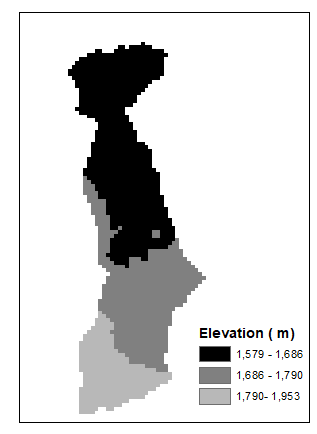if I understand your question well you are saying that how can a watershed which is 1.8km2 can have different parts. If so I think it is better to show you the Dem of this study area?

as you can see on the map there is a large elevation difference even in this micro watershed, which also directly related with soil moisture content
I see, thank you for the explanation. I can’t say much about the moisture variation in your area because I don’t know it. If you have 15 only points per date it makes (statistically) little sense to divide them in even smaller groups.
Did I undestand correctly that you have 60 measurements in total, which were extracted from four different dates? Can you please list the dates?
Yeah you did I used 60 points but accutually i have 90 measurement but I couldn’t get two images in the time of measurement .
The aqusation dates are
October 14,october 26, November 7,November 19, and December 25
HI forum I have a question about the multiple regression model for soil moisture content. the observed and estimated soil moisture content has R2 = 0.8 but the RMSE is 7.8%. I think the best is >=5% so does it mean a model with RMSE is 7.8%. is not useful?
What is the overall value range of your soil moisture?
what do you mean by overall range?
What is the smallest and largest soil moisture value you observd in your measurements? The span of values. Speaking of soil moisture content in percent , an RMSE 7.8 % within 70 % is tolerable, for example, but not within 10 %.
okay,4.8 and 55 respectively
so your range is roughly 50%.
If every predicion of soil moisture is expected to be between 5 and 55% and the RMSE 7.8% this means a predicted value of 15%, at average, could be between 7.2% and 22.8% in reality. If your RMSE was 5%, this range would be 10-20%. We cannot tell you if this is sufficient for your application, but it is good to know the RMSE because it helps to use the soil moisture carefully in subsequent analysis steps.
pardon me but I don’t get your point
Are you aware of what the RMSE stands for?
It is given in the same unit as your data, moisture content in percent. An RMSE of 7.8% does not mean your result is false to a degree of 7.8%. It means that every prediction of the regression has an average error of 7.8% of moisture. That’s a difference when it comes to the evaluation of the results because it tells you about the uncertainty of the prediction. Speaking of your moisture map, 50% moisture +/-7.8% is not much. But 5% +/-7.8% is way more critical.
thank you for your concern and yes i do know for what root mean square error stands .I was trying
to ask about the European space agency GMES requirement for soil moisture products i have seen in some papers it says<= 5%
well, this is what they strive for. But that doesn’t make other approaches invalid which have an RMSE of 5.1% 
I was wondering why always the backscattering coefficient has a negative value?
coarsely speaking, because less energy returns to the sensor than transmitted from it.
After conversion to dB scale, all Sigma0 values below 1 become negative, that is the natural range of this unit.
Do you have the document of GMES requirements of ESA for soil moisture products?
GMES is no longer a thing, all efforts have been bundled under the Copernicus program now.
Can you please specify what you mean by “requirements”?
I mean is there any standard to say a model is bad or good which is developed using Sentinel 1 imagery
For example, let say I have R2 0.4 for an empirical analysis so can I say this model is valid
I don’t think anyone would limit this to a single number of R². Maybe other soil moisture maps have been produced in your area which you can use as a quality reference?
In the end you have to decide if the data you produced is of sufficient quality to follow your research questions. Is it plausible, does it contain systematic errors, are the value ranges realistic, are the spatial patterns realistic? More importantly, how will the R² and the RMSE impact future studies based on these moisture data? Will it introduce errors or can it be used by others? I’m afraid there is no one besides you who can tell this.
Or did I misunderstand your question? Maybe this is something to discuss with your supervisor. Depending on what you have agreed on in the beginning of your thesis (what is the expected results, how do you consider it successful?) you can assess the quality of your work.
Yeah, you did understand my question correctly and I have gat some useful points from your answer. you are right I think I should discuss the detail with my supervisor. Thank you so much for the unconserved support you are forwarding to me.